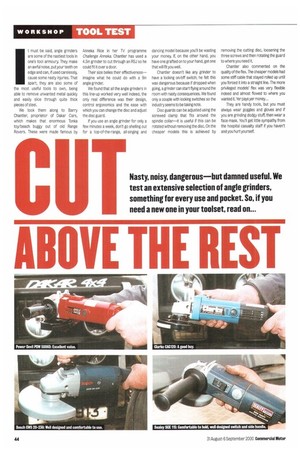OVE THE REST
Page 46

If you've noticed an error in this article please click here to report it so we can fix it.
Nasty, noisy, dangerous but damned useful. We test an extensive selection of angle grinders, something for every use and pocket. So, if you need a new one in your toolset, read on...
t must be said, angle grinders are some of the nastiest tools in one's tool armoury. They make an awful noise, put your teeth on edge and can, if used carelessly, cause some nasty iniuries. That apart, they are also some of the most useful tools to own, being able to remove unwanted metal quickly and easy slice through quite thick pieces of steel.
We took them along to Barry Chantler, proprietor of Dakar Cars, which makes that enormous Tonka toy/beach buggy out of old Range Rovers. These were made famous by
Anneka Rice in her TV programme Challenge Anneka. Chantler has used a 4.5in grinder to cut through an RSJ so he could fit it over a door.
Their size belies their effectiveness— imagine what he could do with a 9in angle grinder.
We found that all the angle grinders in this line-up worked very well indeed, the only real difference was their design, control ergonomics and the ease with which you can change the disc and adjust the disc guard.
If you use an angle grinder for only a few minutes a week, don't go shelling out for a top-of-the-range, all-singing and dancing model because you'll be wasting your money If, on the other hand, you have one grafted on to your hand, get one that will fit you well.
Chantler doesn't like any grinder to have a locking on/off switch; he felt this was dangerous because if dropped when going, a grinder can start flying around the room with nasty consequences. We found only a couple with locking switches so the industry seems to be taking note.
Disc guards can be adjusted using the screwed clamp that fits around the spindle collar—it is useful if this can be rotated without removing the disc. On the cheaper models this is achieved by removing the cutting disc, loosening the three screws and then rotating the guard to where you need it.
Chantler also commented on the quality of the flex. The cheaper models had some stiff cable that stayed rolled up until you forced it into a straight line. The more privileged models flex was very flexible indeed and almost flowed to where you wanted it. Yer pays yer money...
They are handy tools, but you must always wear goggles and gloves and if you are grinding dodgy stuff, then wear a face mask. You'll get little sympathy from the hospital casualty staff if you haven't and you hurt yourself.












































































































